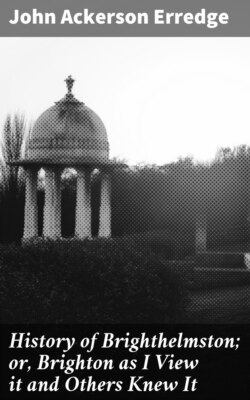Читать книгу History of Brighthelmston; or, Brighton as I View it and Others Knew It - John Ackerson Erredge - Страница 12
Chapter VIII.
THE BARTHOLOMEWS.
ОглавлениеThe chauntry, or free chapel, dedicated to St. Bartholomew, was erected on a piece of land granted by the lord of the manor of Brighthelmston, to the Priory of St. Pancras, at Southover, Lewes, under a quit rent of 3d a-year. It was built to the south-west of the knappe or knab, originally called by the Saxon settlers, cnæp, (the summit or crown of a hill) from its elevated position. It is now generally known by the name of Brighton place. Attached to the chauntry was a dwelling for the two or three monks who officiated there. The chauntry was destroyed by the fire which devastated the town, on the landing of the French, under Primauget, and it never after recovered its accustomed use and influence. The almshouses, which were afterwards built on the site, were sold to the parish in 1733, for the sum of £17, and the dwelling of the monks, called the Prior’s Lodge, became the residence of the vicar of Brighthelmston, after the Reformation.
“Magna Britannia” mentions, “that there was a church near the middle of the town, and it was burnt down some years ago by the French.” This probably refers to the chapel or chauntry of St. Bartholomew. The Prior’s Lodge was pulled down by the Rev. Thomas Hudson, in 1790, the year he was collated to the rectory of Blatchington and vicarage of Brighthelmston. From the style of the architecture, and the decayed state of the timbers, there was ample room for supposing the building to have been erected not later than the close of the thirteenth century. In 1665 the Bartholomews is mentioned as a parcel of pasture. The parish workhouse, demolished in 1823, was erected on its site, and the rest of the space continued nearly plain ground till, in 1774, the market place was built, where the present Town Hall stands. The original market-place, that possessed by the town under the charter of Edward II., was on the cliff, where it had continued from the year 1313 till the close of the seventeenth, or the beginning of the last century; when, that part being sapped by the waves, the building was demolished. The vicarage house, which was substituted for the Prior’s Lodge, by the Rev. T. Hudson, was vacated by the present vicar, the Rev. Henry Michell Wagner, in 1835, and pulled down in 1837. The old vicarage garden was about a quarter of an acre in extent.
The first stone of the present vicarage was laid on the 24th day of June, 1834, and in the following year the structure was completed, and accepted by the Bishop of the Diocese, on the unanimous recommendation of six commissioners, namely, three laymen and three clergymen, to the effect that the exchange would be, in every respect, beneficial. It stands in a garden of exactly two measured acres; and was built by Messrs. George Cheesman and Son.
In 1584, William Midwinter, a sailor, sold the site of the chauntry to Thomas Friend and others, in trust for the said town, in consideration of the sum of £44, which had been raised by subscription among the inhabitants. It had been granted to Lord Cromwell, on the dissolution of the Priory of Lewes; and on his attainder and execution, to Anne of Cleves. It reverted to the Crown in 1557, after the death of that Princess, and afterwards came into the possession of Roger Blackbourne, a farmer of Yorkshire. In 1577 he aliened it to Milo Taylor, servant to Lord Buckhurst, and John Codwell, both of Southover, Lewes. Taylor soon after released his share to Codwell, who sold the whole to Midwinter.
In 1773, an Act of Parliament was obtained for erecting and holding a daily market, Sundays excepted; and the waste land of the Bartholomews being a central situation, and the common property of the town, it was fixed on for the site of the said market. The workmen, who were employed in digging for the foundation of this building, happened to cut through a little cemetery, which seems to have belonged to the chauntry of St. Bartholomew, and were so strongly impressed with superstitious awe, by the bones which they uncovered, that they refused to proceed with their work. The vicar, the Rev. Henry Michell, being informed of their scruples, came to the spot, and instead of exerting his personal influence, which was very great over all classes of his parishioners, or vainly combating the prejudices of ignorance with reason, applauded their veneration for the supposed remains of Christians, but assured them that all who had ever been interred there were rank Papists. Their first prejudice being thus laid by a stronger, the men resumed their work, and turned over the rest of the bones with the apathy of grave-diggers.
About fifty years since, in one of the old tumble-down houses which occupied the site whereon now stand the Schools of Mr. Henry Catt, by the “Knab Pump,” resided Thomas Herbert, a short, stout, fat, and greasy old fellow, possessing but one eye, who professed to make the best sausages out of Germany. He was a maker of small meat pies and sausages; and with these he exhibited his “Publications for Sale.” He was the author of the play, “Too much the Way of the World,” and likewise of “A Brief Sketch of Human Life;” which, with his other literary works, lay cheek by jowl with his comestibles. He had been a butcher; and the following specimen of his literary talent, written in a bold hand, in his window, expressed the cause of the change in his occupation; as he stated he was one
“Who, for want of cash, the shambles spurn’d,
And is for once a play-wright turn’d.”
